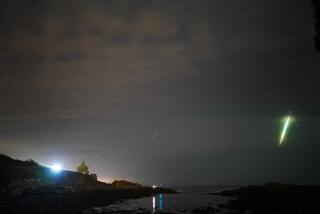Meteor Shower Delays Launch of Discovery
HOUSTON — Space agency officials on Friday postponed the shuttle Discovery’s satellite-delivery mission for a third time to avoid the annual Perseids meteor shower, which astronomers say could be the most spectacular meteor shower in 130 years.
National Aeronautics and Space Administration spokesman James Hartsfield said shuttle managers at Johnson Space Center put off Discovery’s launch, which had been scheduled for Wednesday, until at least Aug. 12.
“You take a certain risk every time you go into orbit,” Hartsfield said. “The problem and the crux of our thinking at the moment is that a lot of the experts think that this meteor shower has a strong possibility of being a historical meteor shower.”
The Perseids shower is related to the comet Swift-Tuttle, which orbits the sun once every 130 years. The Earth passes through a ribbon of debris from the comet every August.
Since Swift-Tuttle passed the sun just last December, the stream of debris the Earth passes through will be hundreds of times more cluttered than it has been since the early 1860s.
“This is like a cosmic garbage truck,” said astronomer Andrew Fraknoi, who teaches at Foothill College in San Francisco. “Since we are closer, we are more likely to get the larger, the fresher, more virgin chunks.”
He added that comet debris, normally the size of dust particles, could be the size of small pebbles. Such bits, traveling at up to 160,000 m.p.h., could seriously damage the shuttle.
The peak of the meteor shower, the time that NASA officials fear most, is expected late Aug. 11, making Aug. 12 the earliest possible launch date.
Discovery’s nine-day mission, during which astronauts will have a practice spacewalk and are to release two satellites, already is three weeks late.
The first launch attempt on July 17 was scrapped about 30 minutes before the planned liftoff because of a failed electronics switch at the pad. The second was canceled in the final seconds because of a faulty steering mechanism in one of the two rocket boosters.
Meteor Storm
The Perseid shower appears each August, and this year’s should be one of the most spectacular ever. The facts:
The Earth is making a historically close pass behind Comet Swift-Tuttle, which is associated with The Perseid shower.
The Perseid usually produces 70 visible meteors an hour. The current shower is expected to surpass the record of 350 per hour set in 1991.
The shower is expected to peak on Aug. 11.
Even the tiniest meteors--the size of a grain of sand--can cause heavy damage to the space shuttle’s windows and skin because they travel at 162,000 miles per hour.
Source: AP, Reuters
More to Read
Sign up for Essential California
The most important California stories and recommendations in your inbox every morning.
You may occasionally receive promotional content from the Los Angeles Times.










